This summarizes a conference document discussing transdisciplinary imaging strategies beyond new media.
The document introduces an international conference that brought together artists, scholars, scientists, historians and curators to explore areas related to imaging, including painting, drawing, film, photography, computer visualization and more. Keynote speakers addressed remediated images, hypermediacy, politics of image making, life sciences/bioart, distributed/networked images at various scales, and machines/computer vision. Participants were asked to consider imaging in relation to transdisciplinarity, materiality/immateriality, mediation, and aesthetics. The conference aimed to move beyond an emphasis on mediation and new media that has become normative, toward a
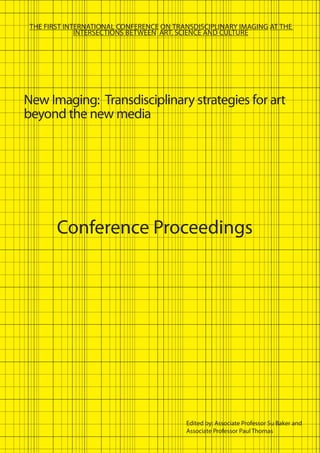




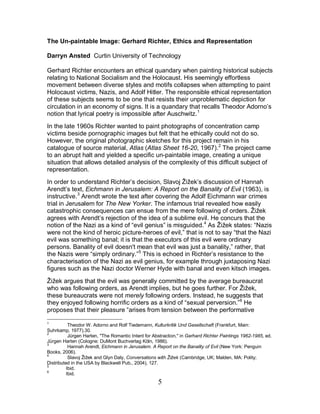


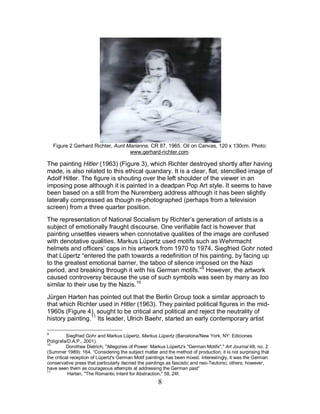






![15
Visualising Matter and Cosmologies: An Example Based on a
Transhistorical Approach
Lucia Ayala Humboldt University of Berlin / Granada University
Dr. Jaime E. Forero-Romero Cosmology Group, Astrophysical Institute
Potsdam
Abstract
We propose a visual dialogue in terms of cosmic matter and structure formation between
cosmology in contemporary astrophysics and Cartesian tradition. More precisely, we
take the system of vortices in Descartes’ physics and connect them with the simulations
of large-scale structure being performed nowadays. The comparison is drawn through
different visual levels: starting with the representational one; followed by the analysis of
the theoretical systems behind them; and, finally, paying attention to their function and
materiality as visual productions. A skilled use of image analysis proves to be a
fundamental tool to stress the continuities and peculiarities between different epochs and
disciplines.
Keywords
Cosmology; Descartes; simulations; structure formation; matter visualisations
“La gran lección filosófica de la ciencia contemporánea consiste, precisamente, en
habernos mostrado que las preguntas que la filosofía ha cesado de hacerse desde
hace dos siglos –las preguntas sobre el origen y el fin– son las que de verdad
cuentan.” (Paz 2009: 179).
The Dutch artist and mathematician Frans van Schooten the Younger (1615-
1660) visualised the system of vortices for Descartes' “Principia Philosophiæ” in
1644. In 1989 the astrophysicists Melott and Shandarin published in “The
Astrophysical Journal” the results of their simulations to visualise large scale
structure. These two images are very similar and, at the same time, are radically
different. In the following pages we propose a multilayered dialogue to
understand the reasons for such similarities and differences.
Shattering motion and Big Bang – Cosmos as history
In “Le Monde”, Descartes proposed a theory explaining the formation of the
cosmos, but not its origin, because it was assumed to be a creation of God. He
supposes an already created matter “that should be imagined as the hardest and
solidest body existing in the world” (Descartes 1644 [1989]: 132). At a given
moment, God started to shake this compressed matter. The shaken parts divided
themselves, triggering the motion and subsequent division of the closest ones in
a kind of “chain reaction.” As a result of this primordial shattering motion, the
matter acquired the most diverse forms, “like pieces exploding when a stone is
broken” (Descartes 1644 [1989]: 136).
This Big Bang-like picture is consistent with the contemporary observational
framework of physical cosmology, where the Universe in the past is understood
to be more homogeneous, denser and hotter than it is today. However, the](https://image.slidesharecdn.com/finalforwebsite-libre-150319013422-conversion-gate01/85/Finalforwebsite-libre-16-320.jpg)

![17
knots would disappear, being reduced to a black smudge. Nevertheless, the
basic topological information of the cosmic web is contained in both cases.
Structure formation – Halos and vortices
Dark matter, the dominant matter component in our Universe according to
contemporary physical cosmology, is not compatible with the framework of
particle physics. It emerges as a consequence of our conceptual understanding
of gravitation: the equations describing its behaviour correspond to a collisionless
fluid that only interacts through gravity. In other words, currently the behaviour of
dark matter cannot be described from basic principles of particle physics (a dark
matter particle has not been detected yet) and, therefore, the only available
approach is through its gravitational effects; to fully explore these effects
numerical simulations are required.
We have mentioned the differences between the renderings of the first large
scale structure simulations and the most recent ones. It is important to assert,
that the main consequence of this sophistication of visual language due to the
improvement in hardware and software, was the possibility to observe the
emergence of new structures inside the cosmic web, namely high concentrations
of dark matter with shapes close to spherical and having a spinning motion.
These concentrations are called halos, and play a fundamental role in galaxy
formation models.
In these models, all galaxies are placed inside a dark matter halo, gravitationally
attracted to other ones. Because of this attraction, they can collide and merge. As
a result, the galaxies inside can fuse, transforming its morphology: a larger
galaxy is formed out of two smaller ones. For instance, the Milky Way and
Andromeda, our closest disk companion, are expected to merge in five billion
years from now. The resulting shape is expected to be spherical, instead of a
disk; the structure changes in this merging process. This is the base of the
hierarchical picture of galaxy formation, where structures grow from the merging
of smaller ones. Their host dark matter halo traces in turn the cosmic web.
This modern chronicle once more echoes Cartesian physics. According to it,
matter is composed of particles in motion revolving round several centres. This
behaviour forms different systems or vortices, each one described as “a heaven
that spins round the star” (Descartes 1644 [1989]: 140). The vortices are also
labelled as “large heavens”, being “very unequal in size” among each other
(Descartes 1644 [1989]: 226). Due to being liquid, their shape is supposed to be
oval. The heavenly bodies are placed in the middle of the vortex to which they
belong. This interplay between heavenly bodies and vortices recalls galaxies and
halos in contemporary conceptions.
Taking this point further, the vortex dynamics also mirrors the hierarchical
merging of halos. The Cartesian particles are by definition constantly moving. As
a consequence, they collide among each other provoking different results:](https://image.slidesharecdn.com/finalforwebsite-libre-150319013422-conversion-gate01/85/Finalforwebsite-libre-18-320.jpg)

![19
The main divergence between each image lays in their function. On one hand,
the vortices are a visualisation of a theory, a visual explanation containing the
key ideas expounded by Descartes in the text. In this sense, the engraving is as
abstract as the theoretical level itself.
On the other hand, simulations of large scale structure are a direct result of a
concrete need to reproduce the available observations. It is an indispensable tool
to verify the theory; the success of a model derives from what is revealed in the
simulation.
The first one visualises the theory; the second one visualises the numerical
experiment that will shape the theory. For that reason, they are radically different
with respect to the contexts to which they belong.
The process of producing images has changed radically since the second half of
the 20th
century. Contemporary scientists have a new relationship with the
images they deal with. In the specific context we present, the main improvements
have been possible thanks to the introduction of simulations as key tools. For the
working astrophysicist, the value of visually comparing the structures derived
from the simulation and the ones from observations, plays a vital role; it escorts
the quantitative labor of extracting and comparing detailed statistics.
For example, in one of the figures included in the “Simulations of the formation,
evolution and clustering of galaxies and quasars” (Springel u.a. 2005: 629) these
two ways of approaching data are contrasted: observation (blue pies) and
simulation (red pies). The comparison between these images allows the fine
tuning of free parameters in the models. This kind of procedure, as well as
preparing mock images of individual galaxies from simulations (how would this
galaxy look like as seen with the Hubble Space Telescope?), have become
standards today in the study of galaxy formation in an explicit cosmological
context. Moreover, these simulations can only be performed with the aid of
advanced computer techniques nowadays available; this mediated process,
resulting in images, is the basic material to work with.
As images, Cartesian vortices and contemporary large scale structure are quite
different from a technical and functional point of view. But conceptually, again,
they are quite close. In “Le Monde” Descartes presents the whole explanation of
his system as a simulation:
“For a short time, then, allow your thought to wander beyond this world to
view another, wholly new one, which I shall cause to unfold before it in
imaginary spaces.” (Descartes 1644 [1989]: 99).
“And my plan is not to set out (as they -the philosophers- do) the things that
are in fact in the true world, but only to make up as I please from [this matter]
a [world] in which there is nothing that the densest minds are not capable of
conceiving, and which nevertheless could be created exactly the way I have
made it up.” (Descartes 1644 [1989]: 107).](https://image.slidesharecdn.com/finalforwebsite-libre-150319013422-conversion-gate01/85/Finalforwebsite-libre-20-320.jpg)

![21
Projecting the Audiovisual Object
Lloyd Barrett Queensland University of Technology
Abstract
An appreciation of live performance commonly posits performers and their bodies as
central to audience engagement. As expanded cinema practitioners extend film outside
the frame and beyond passive linearity, so acousmatic composers have separated the
work of the musician from the body and the sound from its source. The introduction of
notebook computers to live performance rejuvenated this approach, yet the lack of
physicality continues to spark debate around the notion of what constitutes "liveness". In
the theories surrounding musique concrète, Pierre Schaeffer and his associates
constructed a notion of the sound object as a malleable entity not specifically bound by
musical or instrumental tradition, physicality, causality or meaning. Modern digital AV
performers work towards a compositional integrity and performative presence by
expanding this notion towards a unified projection of sound and image.
Contesting popular ocularcentric notions that serve to pigeonhole digital AV performance
as a predominantly visual art, the paper explores the cultural and technological influence
of musique concrète on approaches to AV performance. The audiovisual object is
defined as a potent representational form for the multimodal extension of artistic
expression that can be bound and deployed to enhance live presence in modern digital
music performance.
Keywords
audiovisual, performance, acousmatic, electroacoustic
Introduction
Trends towards the integration of media forms have been noticed in scattered
academic reflections at least since Marshall McLuhan's publications in the 1960s
(McLuhan 1964) and have proliferated with the ubiquity of computer based
operation. As a keen observer of these trends Stephen Holtzman states, “an
expression is an expression of its time [and also] an expression of the idiomatic
nature of the medium by which it is realized” (Holzman 1994). The introduction
of digital hardware to live performance has necessitated a shift in how we
compose, perform and appreciate live media.
The computer considers all media as numeric data and software exists that
makes little to no distinction between media types. An interdisciplinary practice is
therefore a natural outcome of computational arts, driving the emergence of a
distinct form of artistic practitioner. Drawing inspiration from visual arts, cinema,
interaction design, electronic music and acousmatic sound theory, the performing
audiovisualist composes and delivers integrated digital media works utilising the
synchresis of expressive forms to generate and project meaning in performance.
Much has already been written about the relationship between audiovisual
practice and 20th Century visual music. Ian Andrews, theorist and AV artist,
prefers to define contemporary audiovisual art as a live performance practice](https://image.slidesharecdn.com/finalforwebsite-libre-150319013422-conversion-gate01/85/Finalforwebsite-libre-22-320.jpg)
![22
that, “derives its ‘language’ from... formal compositional structures, of time and
rhythm, which are closer to music than to specifically cinematic or visual art
codes” (Andrews 2009). Andrew Hill is even more direct in describing
audiovisual music as a “composition of sound and image informed by traditions
of music in which materials are structured within time [and where] the sound and
image are regarded as equal components joined in the context of a work...” (Hill
2010).
Contemporary audio and visual practice also share a material status; the
electronic signal in wire, or data (Andrews, 2009). Bill Viola states that the video
camera “as an electronic transducer of physical energy into electrical impulses,
bears a closer original relation to the microphone…” than the mechanical /
chemical process of film (Lander and Lexier 1990). This notion of transducence,
a transfer from one energy form to another, is central to any modern digital arts
practice where analogue input, no matter the form, is converted to data. The
source data can be pre-rendered and streamed or transformed and received in
real-time and could be representative of anything at all. The focus ultimately is
placed on the signal, not the performer, who engineers the real-time manipulation
of data into an aural and visual output. Transducence is also at the heart of
electroacoustic music, a form taking its origin from the experiments with
acousmatic theory that have quietly revolutionised audiovisual production and
performance.
This paper extends on the assertions of Hill and Andrews, examining the
influence that musique concrète, acousmatic composition and electroacoustic
performance have had on modern audiovisual practice.
Instantiating the Audiovisual Object
Emerging approaches to audiovisual performance may draw on the richness of
established musical performance practices but they move in many distinct
directions away from what might be considered the traditional instrumentalist
approach. As expertly summarised by sound artist and composer Darrin
Verhagen:
“Prior to the twentieth century and the development of electronics and recording,
there was always a binding between a sonic event and the corresponding action
necessary to cause the sound. To make a noise one needed some equivalent
movement.” (Verhagen 2009).
With the advent of the recorded medium—the wax cylinder and the
phonograph—this binding unravelled. In his Guide to Pierre Schaeffer’s “Traité
des Objets Musicaux” Michel Chion (2002) describes the acousmatic approach
as “indicating a noise which is heard without the causes from which it originates
being seen”. Allegorically inspired by stories of Pythagoras and his akousmats,
this approach came at a time when technology allowed for music to be
reproduced, away from the musicians who initially created it, via radio, records
and tape recorders. As an alternate approach to both sonic perception and](https://image.slidesharecdn.com/finalforwebsite-libre-150319013422-conversion-gate01/85/Finalforwebsite-libre-23-320.jpg)

![24
Media objects in AV work often consist of looped sections of sound and vision,
deployed in a structural pattern or stacked to form an audiovisual collage.
Harnessing the power of evolving digital technology, electroacoustic tools allow
the composer to direct their material towards a near infinite number of stylistic
choices. Pierre Henry claims that his sounds are “...all the more alive for being
removed from their context. They have a new birth, that I will, and an end that I
desire” (Darmon 2007). To borrow a term from the title of a song by German
experimental rock band, Einsturzende Neubauten, this is ‘Brain-Lego’(1989):
short individual clips and long evolving forms that are perpetually broken apart,
transformed and reconfigured into new intriguing shapes, thanks to the
malleability of data. The manner in which performers bind and project these
audiovisual objects is the substance of the remainder of this paper.
Binding Audiovisual Objects
In Haunted Weather David Toop describes the dream of "creating an
overwhelming synaesthesia" as being subservient to the "false assumptions or
deep seated needs [to see a clear] discernible link" between visible actions and
sound production that creates a "warm glow of communication" with the audience
(Toop 2004). While some of the more hyperbolic references to mixed media
work make direct their claims for synaesthesia, it is an incorrect and ineffective
holistic descriptor for AV work given the contextual nature of perception. As
Mitchell Whitelaw explains, “synaesthesia, by definition, occurs in the perceptual
system of a synaesthete, not in the crossed connections of a video synth...
Audiovisual works are artifacts; objects of perception, not perceptions” (Whitelaw
2008).
These AV objects often start as a kind of Frankenstein, cobbled together from
media parts stolen from their original context. Regardless of their incompatibility,
the audience will always process the events unfolding with an eye to
understanding them. Whitelaw defines this ability to evaluate and interpret
simultaneous event streams in our environment as a cross-modality that “binds
percepts into wholes; wholes that map on to ecologically plausible events”
(Whitelaw 2008).
Michel Chion reiterates this binding under the term synchresis, or the
“spontaneous and irresistible weld produced between a particular auditory
phenomenon and visual phenomenon when they occur at the same time” (Chion
1994). Synchresis is a synthesised meaning, through the perception of
synchronised or synchretic signals. Where reduced listening focuses on the
sound without causal or semantic references, the projection of a sound sample
and an image sample together all but guarantees the synthesis of a causal or
semantic connection. The question is how can an audiovisual performer
capitalise on this quirk?
Trevor Wishart describes electroacoustic composition as the use of sonic
metaphor that aims to "unfold structures and relationships in time" (Wishart](https://image.slidesharecdn.com/finalforwebsite-libre-150319013422-conversion-gate01/85/Finalforwebsite-libre-25-320.jpg)

![26
An AV work that features this direct causal relationship is projecting the
transformation or transducence of causal systems into one another. The
performative focus is on the process; however, as per Wishart’s requirements,
the audience needs only to recognise the causal relationships and appreciate the
formal structure(s). In the case of Robin Fox with his laser and synchronator AV
performances, we do not need to know that he is directly feeding his sound to the
visualisation objects as we can identify a formal process and a causal
relationship through his performance. We are also made aware that there is an
engineer manipulating these signals and we then assume that this transformation
is occurring in real-time as real space is framing a performer and their
manipulations. The individual AV elements are made synchretic through the
unification of signal, instantiating a causal relationship via the natural process of
cross-modal binding. As this binding is synthesised, the audiovisualist can
explore alternate combinations, stacked vertically for form, transformed
horizontally for meaning. This reliance on demonstrated repeatable synchresis,
however it is manufactured, is a key feature of AV works and highlights the point
of separation from the Schaefferian school of acousmatic composition.
Projecting Audiovisual Objects
Given the ocularcentric nature of modern society it is understandable that AV is
predominantly compared to the mode of cinema and the medium of film.
However, Paul Spinrad cautions that “our expectations and habits around being
audience members have atrophied ever since movies became popular. [They]
taught us to sit together and pay attention to a dead, unchanging recording rather
than something living and responsive” (Spinrad 2009). Along with differences in
the way film is presented, the moving photographic montage of film responds to a
different form of manipulation than the electronic signal of video but this does not
necessarily change the expectations of an audience or the way they might
perceive that signal. Where audiences identify a performance by the movement
of performers, an expectation is readily shattered when the focus of performance
is not a human body, but a merging / transforming audiovisual signal.
Ian Andrews argues for a contracted mode of performance where the “adoption
of a minimal aesthetic of “static” temporal structures... [combine] with a
contracted focus on the medium within a set of defined material limits” (Andrews,
2009). These limits he believes “[shift] composition towards the exploration of
material (sonic-optical) possibilities...” and ultimately suggest “the “instrument”
and the “medium” are interchangeable (Andrews 2009). The video itself has
been used as a way of distancing the performer from traditional performance as
well, as Tom Ellard explains: the “visuals distracted from the people on stage.
We were against people looking at us ‘performing’ which seemed a bit ‘rock’”
(Barrett 2009).
In an acousmatic presentation the body of the acousmatic “performer” is actively
involved in the performance, however the focus shifts to the projection or
diffusion of a stereo sound to a number of loudspeakers positioned within a](https://image.slidesharecdn.com/finalforwebsite-libre-150319013422-conversion-gate01/85/Finalforwebsite-libre-27-320.jpg)











![38
Bibliography
Belongie, Serge. Computer Vision, Fact & Fiction: an Exploration of Computer
Vision in Film and its Reality [DVD]. Department of Computer Science &
Engineering, University of California, San Diego. (Funded by California
Institute for Telecommunications and Information Technology). 2005.
Carr, Nicholas G. The Shallows: What the Internet Is Doing to Our Brains. 1st ed.
New York: W.W. Norton, 2010.
Clark, Andy. Natural-Born Cyborgs: Minds, Technologies, and the Future of
Human Intelligence. New York: Oxford University Press, 2003.
———. Supersizing the Mind: Embodiment, Action, and Cognitive Extension.
Oxford; New York: Oxford University Press, 2008.
Doidge, Norman. The Brain That Changes Itself: Stories of Personal Triumph
from the Frontiers of Brain Science. Carlton North, Vic.: Scribe
Publications, 2008.
Engelbart, Doug. "Augmenting Human Intellect: A Conceptual Framework."
Washington 25, DC: Air Force Office of Scientific Research, 1962.
Fitzpatrick, Michael. "Mobile Phones Get Cyborg Vision," BBC News, 11 August,
2009, accessed 20 July, 2010, http://news.bbc.co.uk/go/pr/fr/-
/2/hi/technology/8193951.stm
Gray, Richard. "Contact Lenses with Terminator Vision." Telegraph, 27 January,
2008, accessed 20 July, http://www.telegraph.co.uk/science/science-
news/3323248/Contact-lenses-with-Terminator-vision.html.
Greenfield, Susan. Tomorrow's People: How 21st-Century Technology Is
Changing the Way We Think and Feel. London: Penguin, 2004.
Ihde, Don. Technology and the Lifeworld: From Garden to Earth. Bloomington:
Indiana University Press, 1990.
———. Bodies in Technology, Electronic Mediations ; V. 5. Minneapolis:
University of Minnesota Press, 2002.
Jackson, Maggie. Distracted: The Erosion of Attention and the Coming Dark Age.
Amherst, New York: Prometheus Books, 2009.
Levy, David N. L. Robots Unlimited: Life in a Virtual Age. Wellesley, MA: A K
Peters, 2006.
Licklider, J. C. R. "Man-Computer Symbiosis." IRE Transactions on Human
Factors in Electronics HFE-1 (1960): 4-11.
Matyszczyk, Chris. "Woman, Hit by Car, Sues Google for Faulty Directions."
news.cnet.com, May 31, 2010, accessed 20 July,](https://image.slidesharecdn.com/finalforwebsite-libre-150319013422-conversion-gate01/85/Finalforwebsite-libre-39-320.jpg)
















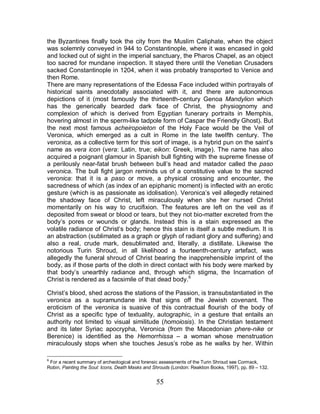














![70
1870 Sandra Philips argues that “[s]urveillance pictures are voyeuristic in anticipation,
seeking deviance from what is there: the creeping presence of enemy activity; telling
changes in the landscape below; evidence of incriminating behaviour, such as spying,
crossing borders illegally, or accepting bribes" (2010). While the voyeurism enacted by
Zwischenräume’s robotic protagonists relies on their visual intelligence to recognise
changes in the environment, their motivation to seek deviations defies military logic of
suspicious behaviour. They seek deviation from the known, desiring difference for the sake
of being different.
The most unique aspect of Zwischenräume is that it physically manifests the machines’
voyeuristic desires. According to Canetti, “[t]here is nothing that man fears most than the
touch of the unknown. He wants to see what is reaching towards him, and to be able to
recognise or at least classify it” (1960). According to Brighenti, Canetti is referring to the
“haptic component of the gaze”, the gaze as social force, revealing the most fundamental
movement of power, “the gesture that seizes” (2010). Zwischenräume enacts and
embodies this transmaterial force and its ‘uncanny touch’ by literally carving the machinic
gaze into the fabric of our built environment. Its sensory images drive the materialisation of
the agents’ evolving perspective, whose disruptive marks and traces, in turn, produce an
image of the politically charged relationships they provoke. The embodiedness of the
robots’ abilities to survey and control, forcing them to operate ‘in the clear’, critically
exposes the power spectacle of operational media (Crandall, 2005).
The machine-augmented wall also presents us with a whimsical view onto a powerful,
autonomous machine, eager to control its environment. It is an image that is probably
more accessible when we’re not finding ourselves jumping back in shock of a hammer
breaking through a wall, followed by the uncanny gaze of an autonomous eye, or captured
in awe of the machine spectacle. Beyond the immediate affect of the wall’s self-destructive
process, we see a machinic voyeur with a hammer, slowly but steadily dismantling not only
its vision barricade but also its own disguising embodiment. A voyeuristic wall undressing
itself.](https://image.slidesharecdn.com/finalforwebsite-libre-150319013422-conversion-gate01/85/Finalforwebsite-libre-71-320.jpg)










![81
they show themselves, actually credits this phenomenological zone with moments of
tangibility that argue against the view that it is a purely theoretical proposition. The bottom
line then is that it grants these semi-dematerialized aspects of painting a tangible, physical
presence that is identified and singled-out in the first instance by seeing, and on this count
it is more than just theoretical.
A painting retains traces of the different processes involved in its creation. Some of these
processes are present in the making (physical) while others present themselves in the
activity of choosing (conceptual) but all exist as part of the constitution of its making. As
such, painting’s re-constitution as an enterprise that should not necessarily depend on
paint, represents the activity, understood here as ‘discipline’ or ‘practice’, as a somewhat
differently configured entity and one that is constantly open to change. It is my belief that
these constituent elements are open to variation and that they offer potential for the
constant reconfiguring and renewal of these variable elements while retaining and
exemplifying their disciplinary embodiment as painting. I posit the plausibility of painting
being understood as a ‘discipline’. As such, it would no longer be reliant on the idea of a
self-regulating medium in regard to the work’s material constitution. Instead it can force
such ideas into question to the point where the use of paint itself is marginalized, or made
to appear unnecessary.
This paper effectively questions conventional terms of reference i.e. the material traditions
or common denominators that historically, have informed and arguably entrenched specific
art forms. I contend that terms such as ‘disciplinary definition’ (as noted in the call for
abstracts), are now too unspecific, misleading, and at worst prescriptive. How do we
choose to define discipline, under what terms, and whose agenda? While supporting a re-
apprehension of the image, this paper stresses the folly of viewing disciplinary boundaries
today as markers of an outmoded, materially led ideological framework. The folly of this is
highlighted by the notion that, as a discipline, painting today is no longer bound to its
former material tradition, a tradition that, until the twentieth century, had historically
informed its terms of reference. The acknowledged ‘boundaries of disciplinary definition’
rests, I believe, on an outmoded idea of discipline, evades the bigger issue of what the
term discipline may now entail and echoes, or at very least appears to condone, a more
essentialist view of disciplinary boundaries (Greenberg?).
References:
Baldacinni, César (1961) Relief tôle.
Assemblage of pieces of automobile bodywork mounted on a frame.
[Internet image]. Available from
<http://artintelligence.net/review/?p=497> [Accessed 1st
November 2008]
Goodman, Nelson. (1976). Languages of Art: An Approach to a Theory of Symbols,
second edition. Indianapolis: Hackett Publishing Company.
Krauss, Rosalind E. (1999). A Voyage on the North Sea: Art in the Age of the Post-
Medium Condition; London: Thames & Hudson Ltd.
Wittgenstein, Ludwig. (1976). Philosophical Investigations. Edition 3. Originally published
1953. Great Britain; London, Billing & Sons.](https://image.slidesharecdn.com/finalforwebsite-libre-150319013422-conversion-gate01/85/Finalforwebsite-libre-82-320.jpg)










![92
For Paul Carter the tyrille1
of the Boorong is best understood as “primordial space” reminiscent
of the chora of classical Greek cosmology: “The tyrille was not a clearing but an opening, a
cleaving in which all things came into being, doubled like reflections in their proper places”
(Carter, 2003: 7).
Today, the heavens remain essentially unchanged and, as Paul Carter says, ‘in their proper
places’ but the lake and its environs, cleared of most native vegetation in the twentieth century,
is an ecologically impoverished zone1
. The heavens are left to mirror the land as it might be
remembered, not as it has become. It is a double (‘reflected’) loss: the absence of an intact
ecological surface and the undoing of an imagined pairing or reciprocity of earth with sky.
The Boorong story inspired its use as a metaphor for the global environmental crisis
andproduced two questions: First, is it possible to imagine Lake Tyrrell again as an optical
aperture or plane? Second, could the regions ecological ‘tragedy’ (and by association, the
world’s) be evoked through the lake’s poetic ‘re-pairing’ with the heavens in photographs
created by starlight on site? Such a re-pairing could infer a syzygy of the project title: the
yoking together of two or more objects or the alignment of three or more celestial bodies.
2. Project Overview
The Syzygy project took place in three phases over four years. First, ‘terrestrial’ and ‘celestial’
source negatives were made and found, respectively [see Fig 1]. A year of fieldwork produced
the earthly set: photographic shadowgrams on large sheets of low-speed orthochromatic
gelatin silver film recording live native invertebrates and reptiles gathered from around Lake
Tyrrell and exposed to flash at night on site [see Fig. 2]. The celestial negatives were borrowed
astronomical survey photographs on glass plate. The starlight exposures were then executed
at a site at the northern tip of the lake most distant from light pollution. The sky-facing shadow
films were exposed to ambient starlight under their respective pre-prepared negatives laid after
dusk on tarpaulins pegged to the lakebed in daylight [see Fig. 3]. Many shadow-films–a high-
speed panchromatic gelatine silver emulsion cut to the same size as the astronomical plates–
were exposed simultaneously [see Fig. 4]. To ensure a predominance of starlight, exposures
were restricted to a few clear dark, nights each month free of the reflected sunlight of the moon
and bright planets. Approximately 270 films were exposed to the stars in 15 events over three
years. Finally, the developed films were chemically treated and mounted on glass preparatory
to exhibition. A selection of over 100 of these film/glass objects has been configured into some
two dozen triptychs and one much larger multi-segment artwork.
A chance conveying of the Boorong story by independent author, artist and scholar Paul Carter
inspired the Syzygy idea. Later, Paul Carter (assisted by Dr Emily Potter) entered into
extensive discussion and writing about the site and project process. The project was also, in
part, a response to Paul Carter’s Nearamnew pavement at Federation Square, Melbourne, a
work similarly informed by the Lake Tyrrell story. Physicist and lecturer in Science Education in
the Melbourne Graduate School, University of Melbourne Dr Maurizio Toscano was the
principal scientific collaborator. He discovered and brokered access to the astronomical survey
collection, assisted in plate cataloguing, identification and selection, prepared the long-range
starlight exposure timetable, calculated field exposures and helped solve nagging technical
1
According to Paul Carter (Carter, 2003: 7) “explorer Edward John Eyre named the lake after the Aboriginal
word ‘derell’ meaning above, sky or space”, later rendered as ‘tyrille’ by William Edward Stanbridge.
1
Victorian state government reports have detailed the environmental ‘hazards and conflicts’ arising from
large-scale land clearing and settlement in the Mallee region, including Lake Tyrrell. For example, only 7 of
an original estimated 25 species of small to medium-sized native mammals and marsupials survive in the
region. (LCCV, 1974: 153-173 & 219-229, LCCV, 1987: 285-328).](https://image.slidesharecdn.com/finalforwebsite-libre-150319013422-conversion-gate01/85/Finalforwebsite-libre-93-320.jpg)




![97
recorded the night without a camera but being unmediated, these images are shadowless. The
precisely choreographed in situ photogrammetry and plein air starlight exposure procedures
repeated over three years lent these events the character of faux-scientific ritual or
performance, not unlike the site-specific actions of Joseph Beuys. The intimacy between artist,
material and site echoed land artists like Richard Long or David Nash who seek the
“equivalent…of nature poetry” (Malpas, 1998:38). The invertebrate and reptile imprinting
directed by bodily gestures and chance parallel the charcoal frottages of painter John
Wolseley, the earth rubbings of Michelle Stuart (Casey, 2005: 59-63) and the serendipitous
animal art of Olly and Suzi (Baker, 2002:87).
Syzygy’s indexicality (shadow and light) is therefore threefold: one of sense–the bodily and
binocular memories of human participants–and two of record: the kinetic ‘touch’ of creatures
and plates imprinting image-holding film surfaces and, pre-eminently, the photochemical
punctum of ancient cosmic photons energizing silver halides. All three phases of Syzygy, the
sourcing and making of the negative imagery, plein air exposure method and film outcome may
be said to reflect on the digital revolution by virtue of the very absence of electronic imagery. In
so doing, the project revivifies analogic methods as an arena for speculative research and
critique. Clearly, there is an elegant logic to employing photochemical rather than digital
techniques in pursuing indexical semiotic strategies: dispensing with the camera, glass optics
and the conventions they signify–monocular perspective, the picture frame, focus point, depth
of field, ‘the view’–enabled a revisionist, ‘ambient’ rendering of the schema ‘landscape’.
The formal resolution of the finished Syzygy films, trimmed and face-mounted on starfire glass
panes bordered by a circular black mask screen-printed on the opposing side, silently infer the
glass astronomical survey archive, magnification optics and zodiacal wheel [see Fig. 5]. In an
otherwise degraded landscape, the invertebrates (and some reptiles) gathered around Lake
Tyrrell offered a bounteous and evocative iconography of locality, fragility, otherness,
sociability, competition, threat and mortality [see Figs. 6, 7]. Seen in reproduction at life-scale,
these creatures present a potent terrestrial analogy with the specks, streaks, wafts and
explosions of the night sky, analogy returned in the otherwise faint and unseen contents of the
heavens massively enlarged for clarity by telescope [see Figs. 8, 9]. Alone and counterposed,
the two sets of masked photographs draw our gaze to the heart of the ecological idea: our
inescapable embedment within the planetary evolutionary knot, interdependent biosphere and
unimaginably vast and old universe.
Figure 4. Making the celestial exposures. Left: the dark horizontal line in middle-ground is the Syzygy film array lying on the
dry bed of Lake Tyrrell during their 56-minute exposure to ambient starlight. Photograph by Glenn Wilson, 2008. Right: star-
trail reflections on the films during their nocturnal exposure on the lakebed. Photograph by Viren Mohan, 2009.](https://image.slidesharecdn.com/finalforwebsite-libre-150319013422-conversion-gate01/85/Finalforwebsite-libre-98-320.jpg)


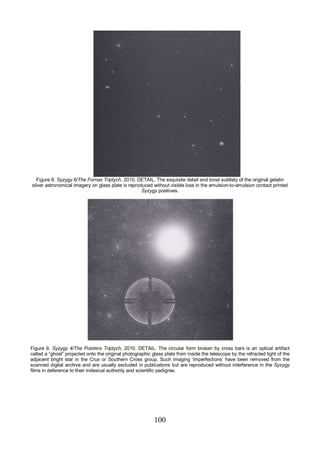



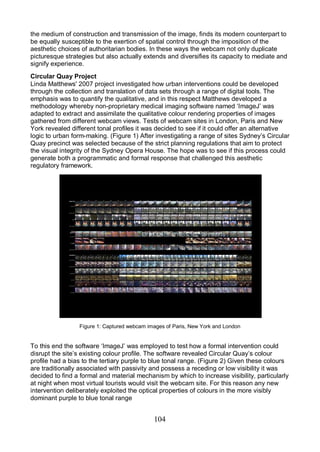
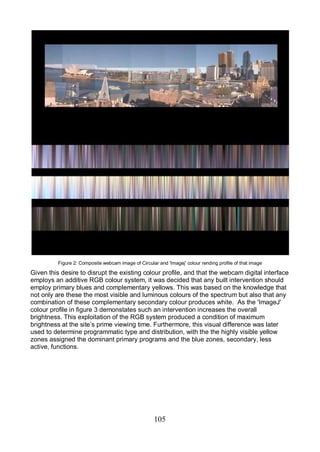







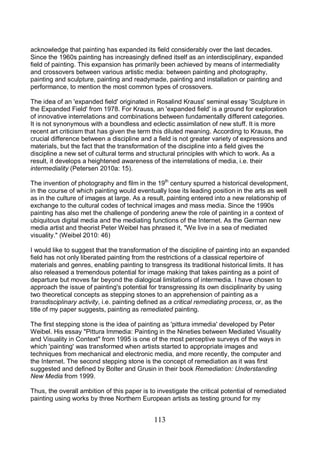
![114
argument. In this context, 'critique' has a double meaning. It should be understood to be
the self-critique of the disciplinarity of painting and the related notion of autonomous art
forms; but is should also be understood as the critique of the democratized visual culture
of techno-mediated images. My point is that in remediated painting, the two meanings of
critique – self-critique and cultural critique - are interrelated, as demonstrated by the works
of the three artists I have chosen as my examples:
The first artist is the Dane Thorbjørn Lausten who started as a painter in the late sixties,
moved into kinetic art and electronic sculpture and then on to what we usually call 'new
media art'. He is one of the few Danish artists who has investigated the field between art
and technology consistently and in an international context. In the last two decades he has
made a series of data projections based on scientific data. One could perhaps describe
this part of his work with the title of the conference series as consisting in a
transdisciplinary imaging positioned at the intersections between art, science and culture.
The second artist is the German painter Katharina Grosse. She creates huge site specific
installations, spraying paint on monumental sculptural objects or on the exhibition space
itself. In this way she redefines the very concept of 'a painting' or 'an image' as she
transforms the painted artifact into a space or a place that the visitor must enter and pass
through.
My third example is the British artist David Bachelor who is also a writer and a graduate of
Birmingham's interdisciplinary Centre for Contemporary Cultural Studies (Holman 2007:
46). Since the late 1990s, he has concentrated on colour in urban environments, and this
interest in colours is apparent both from his works and his writings. In 2006 he summed up
the ambiguity of his relationship with painting in a way that seems to me to articulate a
dilemma that many contemporary artists are confronted with,
“My relationship with painting is ambivalent. I use the term in its strict sense, which is […]
motivated by […] a simultaneous attraction to it, and repulsion from it. […] I work in a studio
and my work in studios is certainly informed by painting. Even if my work is mainly three
dimensional and some would call it sculpture, but I don't think I would. Painting still informs it
more than anything else. I can't get away from painting entirely, at the same time I can't do
it.” (Batchelor 2006/7: 1)
I have chosen these three artists, firstly, because I consider them to be radical artists that
push back the frontiers of painting. Secondly, because they hold very different positions in
today's expanding field of painting. Introducing the diversity of this field by way of a few
examples does not enable me to cover the whole spectrum, but hopefully to uncover some
important strands of transdisciplinarity. To simplify in order to clarify, one could say that
Lausten's approach is constructivist, Grosse's approach is phenomenological and
Batchelor's take on painting is materialist.
I will now pick up my theoretical line of argument by returning to my first stepping stone.
Peter Weibel fuses the words 'immediate' and 'mediation' in the word immediation to
describe what happens when various kinds of technical images are integrated in a
painterly practice. Following Weibel's definition, immediation refers to a process of
travelling through a number of different media, which results in a 'painting' – in the widest
sense of the word – that rearticulates the question of the nature of the visual and the](https://image.slidesharecdn.com/finalforwebsite-libre-150319013422-conversion-gate01/85/Finalforwebsite-libre-115-320.jpg)

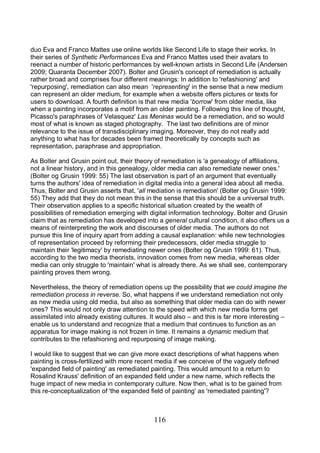




![121
Moreover, the installation also made it clear that scientific visualizations are not only
'science', but also an aesthetic practice based on the transdisciplinary language of visual
abstraction. According to Lausten, we have an obligation to investigate how they function
and make up our knowledge of reality. Art has a special stake in this. On the one hand, it
is partakes in the construction of knowledge and visualizations; on the other hand, art can
also act as a critical investigator of these constructions. As Lausten puts it,
“[…] I do not think it is any exaggeration to claim that art constitutes our knowledge. In this
connection, art is not to be understood in terms of those kinds of platitudes popular among
the general public but ought to be related to the term téchne, in its original meaning.”
(Lausten 2008: 32)
To sum up, Lausten redefines his work as an artist rooted in painterly abstraction by
linking art to téchne, i.e. the ancient Greek concept of cultural activity as comprising
craftsmanship as well as the disciplines later renamed art. In Lausten's projects Magnet
and Now – the Polar Space, a painter's imagination and the formal means of systemic
painting are cross-fertilized with techniques of scientific imaging. The resulting remediated
paintings presented themselves to the eye as computer visualizations imbued with
aesthetic 'painterly qualities' such as exquisite luminous colour schemes and aesthetically
pleasing compositions. This is not an inter-media 'hybrid' of painting and computer images
in the tradition from Warhol's silkscreen paintings and Weibel's 'pittura immedia'. Lausten
accomplishes something else: His analysis of how scientists construct images of the
empirical world by using computer technology reinvents painting as a kind of meta-critique
of scientific discourses and imaging.
In recent years a remarkable number of painters have begun to explore the possibility of
developing painting in the opposite direction of digital virtual spaces. Today, much of the
experimental energy is put into exploring the physical and tangible spatiality of painting.
Artists are investigating painting’s relations to objects, space, place, and the ‘everyday’. In
doing so, they are remediating ‘painting’ through more recent art forms like the
readymade, site-specific art and installation art. The techniques of installation art have
added a wide range of expression to the palette of artists such as Katharina Grosse who
uses the spatiality of installation art to translate painting from plane to space and wrap the
work around the viewer as a tree-dimensional environment. Thus, her works elicit the more
bodily and performative type of response typical of installation art. One could say that she
creates a usually temporary stage-like event, and that this event or spatial situation gives
substance to the dream that illusionistic paintings have always played on: The dream of
literally walking into the painting in order to explore it more thoroughly and empathise more
deeply with it (Petersen 2010b: 132). Grosse accomplishes a refashioning and
repurposing of painting by integrating the physical world in her works. She uses the space
of buildings – walls, partitions, floor – as painting surfaces, and sometimes also physical
objects and the materiality of soil. In this way, she involves the visitor intensely on the
sensory as well as the cognitive level.
In 2009 she made a site-specific long-term installation that transformed the 150-meter long
Art Axis at the museum Arken into a brightly coloured imaginary world. The exhibition was
entitled Hello Little Butterfly I love You What's Your Name, and was the second in a series
of three exhibitions on the topic of Utopia. Grosse tied paintings, sculptures and large
mounds of earth together with monumental site-specific paintings executed directly on the
walls and floors so that the solids of architecture dissolved into optical illusions. The
installation offered the visitor the joy of going away, of leaving grayness and entering](https://image.slidesharecdn.com/finalforwebsite-libre-150319013422-conversion-gate01/85/Finalforwebsite-libre-122-320.jpg)
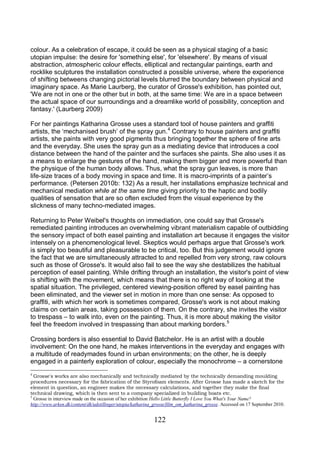








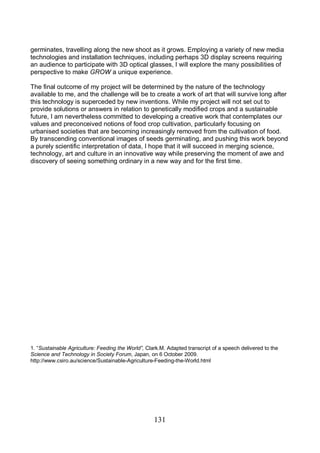
![132
After the Screen: Array Aesthetics and Transmateriality
Mitchell Whitelaw University of Canberra
Glowing Rectangles
For all the diversity of the contemporary media ecology - network, broadcast, games,
mobile - one technical form is entirely dominant. Screens are everywhere, at every scale,
in every context. As well as the archetypal "big" and "small" screens of cinema and
television we are now familiar with pocket- and book-sized screens, public screens as
advertising or signage, urban screens at architectural scales. As satirical news site The
Onion observes, we "spend the vast majority of each day staring at, interacting with, and
deriving satisfaction from glowing rectangles" [1].
Formally and technically these screens vary - in size and aspect ratio, display technology,
spatiotemporal limits, and so on. They are united however in two basic attributes, which
are something like the contract of the screen. First, the screen operates as a mediating
substrate for its content - the screen itself recedes in favor of its hosted image. The screen
is self-effacing (though never of course absent or invisible). This tendency is clearly
evident in screen design and technology; we prize screens that are slight and bright -
those that best make themselves disappear. Apple's "Retina" display technology claims to
have passed an important perceptual threshhold of self-effacement, attaining a spatial
density so high that individual pixels are indistinguishable to the naked eye [2]. The second
key attribute of contemporary digital screens is their tendency to generality. The self-
effacing substrate of the screen is increasingly a general-purpose substrate - unlinked to
any specific content type; equally capable of displaying anything - text, image, web site,
video, or word-processor. This attribute is coupled of course to the generality of
networked computing; since the era of multimedia the computer screen has led the way in
modeling itself as a container for anything (just as the computer models itself a "machine
for anything"). The past decade has simply seen this general-purpose container proliferate
across scales and contexts, ushering us into the era of glowing rectangles.
However over the past decade in design and the media arts, a wave of practice has
appeared which as this paper will argue, resists the dominance of the glowing rectangle.
Given the near-total cultural saturation of the screen, this is unsurprising, given the
ongoing cultural dance of fringe and mainstream in which this practice participates. This is
not simply a story of resistance however. In proposing and describing two particular strains
of "post-screen" practice, this paper aims firstly to outline the shared terms of their
relationship with the screen, and in the process develop a more detailed sense of these
conceptual devices of generality, outlined above, and its opposite, specificity. Secondly,
and more briefly, it outlines a theorisation of this practice, invoking transmateriality, an
account of the paradoxical materiality of (especially digital) media, and Gumbrecht's notion
of presence.
2. Arrays
During the opening ceremony of the 2008 Beijing Olympics, a huge grid of
drummers assembled in the stadium, each standing before a large square fou drum, a
traditional Chinese instrument [3]. Each drum was augmented with white LEDs mounted
on its surface, triggered with each drum stroke. The drummers formed a vast array of](https://image.slidesharecdn.com/finalforwebsite-libre-150319013422-conversion-gate01/85/Finalforwebsite-libre-133-320.jpg)
![133
discrete audiovisual elements, precisely choreographed in the style of these spectaculars.
Human pixels, but coarse and resolutely human; at one point the drummers
desynchronised entirely, forming a thunderous grid of flickering light. In a ceremony
created for the (broadcast) screen - to the infamous extent of splicing computer-animated
fireworks into its telecast in place of real ones - the drummers were a moment of
involution. Their array echoed all the other, more conventionally self-effacing screens
threaded through the event; but it also inverted some of their key attributes. Firstly its
substrate, instead of receding behind "content", came forward; if anything substrate and
content were one and the same. Secondly, while this array nods towards the generality of
the screen in its choreographed patterns - which like the patterns on a screen could be
"anything at all" - it veers strongly in the opposite direction, towards the here and now,
what I will call specificity [4]. The poetics of this array rely on the specificity of its elements
- the drummers, drums, and their solid-state illumination - rather than the patterns that play
across it.
The drummers are one popular example of a formal trope we can find throughout media
arts and design practice over the past decade. Daniel Rozin's 1999 Wooden Mirror is one
of the earlier examples [5]. Wooden Mirror is an array of square wooden tiles embedded in
a large octagonal frame, along with a bundle of custom electronics. The tiles are fitted with
servomotors, so that each one can tilt up and down on its horizontal axis. As its angle to
the light changes, each tile appears brighter or darker. Rozin wires up the array to a
videocamera, to complete the mirror circuit: the brightness of pixels in the incoming image
drives the angle of the tiles. Given the overtly visual logic of the work, it's interesting that its
sound is equally striking: the wooden tiles clatter like mechanical rainfall, sonifying the rate
of change of the image; as the image becomes still, the clatter dies off to a low twitching.
Again, this array emphasises the material presence of its substrate. The tonal "generality"
of the wooden mirror is functional enough to be familiar, but the coarse mechanical
clattering of these pixels makes them inescapably specific.
Rozin has made many similar mirrors; notable is Trash Mirror (2001) where the individual
elements - irregularly shaped pieces of rubbish - are packed into a freeform mosaic [6].
This array moves one more step away from the homogeneous generality of the digital
screen. Here the elements are irregular in size and shape, but also carry their own specific
textures and colours. In Mirrors Mirror (2008) the regular grid returns, but the array
elements are themselved replaced by mirrors; as these tilt they reflect different parts of the
environment [7]. Here the location of the tonal "content" in the array is, like the image
source, deferred to the environment. In a familiar digital screen, image elements are
luminous modules whose colour value is independent and absolute. In Rozin's Wooden
Mirror that value becomes relative - tonality is based on self-shading, which depends on
the lighting of the work. In Mirrors Mirror this relativity is multiplied; each element will
reflect a different portion of the environment, depending on both its angle and the
viewpoint of the observer.
In many cases these media art arrays depart from the two-dimensional grid entirely.
Robert Henke and Christopher Bauder's ATOM (2007-8) is an eight-by-eight grid of white
helium balloons, each one fitted with LED illumination and tethered to a computer-
controlled winch [8]. The grid becomes a mobile, configurable light-form, tightly coupled
with Henke's electronic soundtrack in live performance. This array lowers its resolution](https://image.slidesharecdn.com/finalforwebsite-libre-150319013422-conversion-gate01/85/Finalforwebsite-libre-134-320.jpg)
![134
drastically, and limits its generality in one dimension (monochrome elements), but extends
its reach (literally) into a third axis. ART+COM's 2008 kinetic sculpture at the BMW
museum uses a similar configuration, but a higher "resolution" - in this case 714 metal
spheres are suspended from motorised cables, forming a smoothly undulating matrix - a
sort of programmed corporate ballet [9]. Cloud (2008), a sculpture in Heathrow airport by
London art and design firm Troika, illustrates another permutation: here a 2d array forms
the skin of a large three-dimensional sculptural form. In this case the elements are
electromagnetic flip-dots - components often used in airport signage before it was
overtaken by glowing rectangles [10]. As in Rozin's Mirrors, Troika consciously exploit the
materiality, gestural character and the sound of these retro-pixels. rAndom International's
2010 Swarm Light demonstrates a "saturated" 3d array [11]. The work consists of three
cubic arrays of white LED lights, each ten elements per side; these cubic volumes host a
flowing, flickering "swarm" of sound-responsive agents which traverse the space,
brightening or dimming the array as they move.
The work of British designers United Visual Artists offers a useful longitudinal study in
post-screen imaging; in particular their work addresses one of the central technical players
in this field, LED lighting. UVA's first project involved a huge LED array that formed the
stage set of Massive Attack's 100th Window tour [12]. Unlike more screenful video
backdrops, this low-res grid had an inescapable presence, hung directly behind the band
and looming over the stage. Rather than an image machine, UVA treat the grid as a
luminous dot-matrix for the twitching alphanumeric characters of real-time data. In
subsequent work UVA develop this approach in a number of directions, but digitally
articulated light - enabled by the LED - is a recurring theme. In Monolith (2006) UVA use a
pair of large, full-colour LED screens, but treat them as a dynamic light source rather than
a substrate for images; subtle gradients and washes of colour spill over the audience and
into the installation environment, coupled with generated sound [13]. In Volume (2006),
another installation piece, the array elements are long vertical LED strips, again treated as
generators of pattern, colour and sound; the work forms an interactive field as each
element responds to nearby activity [14]. In the context of this steady dismemberment of
the screen, UVA's latest work The Speed of Light is notable in that it leaves LED arrays
aside entirely [15]. Instead it uses installed lasers manipulated into dynamic, walk-in
calligraphy, as if light had been finally prised away from its digital substrate, and turned
loose in the environment.
Beyond their formal similarities, these arrays share some core approaches and contexts
which provide a coherent portrait of a sort of post-screen practice. These works adopt one
key feature of the screen - the "generality" of an articulated substrate - but trade it off to
varying extents for more "specificity" - exploiting the local, particular materiality of the work
and its environment. This specificity is also technological, reflecting a practice that crafts
hard- and software into idiosyncratic configurations, rather than using off-the-shelf
infrastructure. Light is a strong theme, in particular the solid-state, digitally addressable
light of the LED (essentially a free-floating pixel). However the optical in these arrays is
always tightly coupled with other modalities, especially sound, which is either a cherished
byproduct of the array mechanism (as in Rozin's Mirrors and Troika's Cloud) or generated
by the array elements themselves (as in the drummers and UVA's Volume). A quality of
liveness is linked with the turn to specificity and being-in-the-environment; from the "live
data" of UVA's Massive Attack show, to the live interaction and generation of their later](https://image.slidesharecdn.com/finalforwebsite-libre-150319013422-conversion-gate01/85/Finalforwebsite-libre-135-320.jpg)
![135
installations, to the live video driving Rozin's Mirrors. Performance and temporary
installation are the dominant forms here - emphasising the intensified moment, rather than
the any-time of static content.
3. Projection Mapping and Extruded Light
In one sense these arrays present a disintegration of the screen - they pull its elements
apart and embed them in the environment. In another strain of media arts practice,
something like the converse occurs, though with what I will argue are similar interests and
agendas. In this approach screen-like technologies are used intact, rather than
decomposed; but their function and their relationship to the environment is transformed.
These works reverse-engineer the digital image, exploiting its digital (general) malleability
in order to fit it to a specific environment.
The work of Norwegian artist HC Gilje illustrates one trajectory of this second post-screen
approach. Gilje's work from the late 90s was in live digital video, with his ensemble
242.pilots. This practice was linked to the burgeoning activity in experimental electronic
music at the time; here again, performance, improvisation and the intensified moment -
what Gilje calls an "extended now" - are central concerns, though the work is strongly
screen-focused in its results [16]. In Gilje's work over the following decade, he
demonstrates another path towards the post-screen. Gilje's nodio (2005-) is a custom
software system for distributing video content across collections of linked "nodes" [17]. In
drifter (2006) these nodes are manifest as a ring of twelve screens which form a linked
audiovisual interspace [18]. With dense (2007) these nodes take on a more sculptural
presence - hanging strips of fabric illuminated from both sides with a tailored video-
projection [19]. Here Gilje adapts the screen technology of the video projector to a
sculptural environment, pushing it one step away from image and towards illumination.
The work also depends on a specific material surface - the translucent weave of the fabric
enables the double-sided layering of pattern.
shift (2008) develops this approach: a technique known as projection mapping, in which
the projected image is reverse-engineered to fit a specific surface [20]. In shift Gilje's
nodes are simple rectangular boxes, constructed from plywood. Using more custom
software, the artist illuminates a cluster of these boxes with precisely mapped projected
images. The coupled sound emanates from speakers housed in each box, so the objects
are again audiovisual (and acoustically distinct) nodes; Gilje composes material for this
environment in search of what he terms "audiovisual powerchords" - moments of intense
juxtaposition and interplay [17]. In blink (2009) Gilje dispenses with the boxes, instead
treating the bare installation space. Simple, geometric elements - angular lines and bands
of tone and colour - are reflected and modulated by the space itself, diffusing from irregular
polished floorboards and painted walls [21]. The work plays the room with articulated light,
carefully matched to its geometry in way that heightens our awareness of the interplay of
space, light and materials.
Projection mapping has recently flourished in "visualist" practice across art, design and
performance contexts; trompe-l'oeil architectural facades are one popular genre,
manipulating the built environment by rendering it with a tailored skin of articulated light
(see for example Urbanscreen's Kubik 555 [22]). German designers Grosse 8 and
Lichtfront demonstrate a logical extension of the technique, using multiple projectors to](https://image.slidesharecdn.com/finalforwebsite-libre-150319013422-conversion-gate01/85/Finalforwebsite-libre-136-320.jpg)
![136
create an "augmented sculpture" in the round [23]. Another notable example is Scintillation
(2009) by Xavier Chassaing, a digital stop-motion film in which projection mapping is used
to layer a domestic environment with luminous swirls of particles, igniting the petals of an
orchid and tracing the curves of a moulded plaster cornice [24]. As in Gilje's blink,
Scintillation emphasises the ambience of the projected light - reflections and diffusions are
heightened by hand-held macro cinematography, artfully producing an impression of
material texture. But in the process it raises some interesting problems for our analytical
premise - a shift from the screenful image to something more live and specific. For
Scintillation is absolutely a work of filmmaking; here projection mapping - the tailored
materialisation of the image - is deployed as a technique for producing generalisable,
substrate-independent image content.
The final example in this survey addresses the same tension. In their recent short film
Making Future Magic, London design agency Berg give an ingenious demonstration of
both the material turn of post-screen imaging, and its recuperation as image content [25].
Berg developed an animation technique combining multiple-exposure stop-motion with a
hand-held source of articulated light - specifically the glowing rectangle of the moment,
Apple's iPad. 3d forms are digitally modelled and animated, then decomposed into
sequences of 2d slices. These slices are then replayed into the environment, and thus
recomposed into 3d forms, by moving an iPad screen over successive still frame
exposures. As Berg term it, this is "extruded light" - as in UVA's latest work, it's as if light
itself has been unpinned from its substrate. The results are a beguiling combination of
loose, organic light painting with simple 3d geometry and DSLR imaging. As Berg frame
the work, it fits entirely within the post-screen turn proposed here. Responding to a brief
around "a magical version of future media", Berg are "exploring how surfaces and screens
look and work in the world ... finding playful uses for the increasingly ubiquitous ‘glowing
rectangles’ ..." [25]. Again the material embeddedness of this articulated light is
emphasised - the way it reflects from puddles and diffuses through foliage. Screen as
object in the world, rather than window to somewhere else. As in Scintillation however the
inescapable irony is that the outcomes of this work are entirely bound up with screenful
images - with the generalising infrastructures and distribution pipelines of social image
sharing, print-on-demand and networked video.
4. Transmateriality and Presence Culture
To recap briefly: the ubiquitous digital screen is characterised by both generality - an ability
to display any content at all - and self-effacing slightness - it tries to make itself disappear
as a neutral substrate for content. In contrast to these tendencies this paper describes two
distinct but parallel strains of "post-screen" practice in the media arts and design. Arrays
mimic the grid configuration of the screen, but lower its resolution and emphasise the
material presence of the array elements - their local and individual specificity is balanced
with their malleable generality (their ability to carry anything-at-all). Projection mapping and
"extruded light" practices also emphasise specificity, materiality and a local, performative
being-in-the-world, but they do so by different means - exploiting the malleability of the
digital screen (and the computational representations it hosts) in order to make it intensely
site-specific. To the extent that they both adapt and resist the attributes of our familiar
glowing rectangles, we could describe these practices as post-screen, but this "post" is
nothing like a conscious critique, let alone a revolutionary break. However hard they may
pull towards specificity and local materiality, they are readily - by design or necessity -](https://image.slidesharecdn.com/finalforwebsite-libre-150319013422-conversion-gate01/85/Finalforwebsite-libre-137-320.jpg)
![137
recaptured as screen fodder.
Both these post-screen tendencies and their screenful recuperation can be usefully framed
through the notion of transmateriality, a concept that attempts to capture a fundamental
duality in digital (and other) media: they are everywhere and always material, yet often
function as if they are immaterial [26]. In a transmaterial view media always operate as
local material instances (this is their aspect of specificity) yet retain the ability to hold
specificity at bay - resisting the contingencies of flux - to create a functional generalisation
in which this pixel is the same as that one, the email I send is the same as the one you
receive, and one node on the network is much the same as any other.
In the glowing rectangle paradigm functional generality is entirely dominant. The work
considered here, on the other hand, revels more in the pleasures and practices of
specificity - the clatter of servo-actuated wood or the play of light on this particular wall. In
their push towards liveness (of interaction or data), performativity, their integration of
sound, and their emphasis on evanescent materiality, these works evoke what Hans Ulrich
Gumbrecht would call "presence culture" - that mode of apprehending the world which is
characterised by fleeting but intense moments of being, and a sense of being part of the
world of things, rather than outside it, looking in [27]. Gumbrecht constructs presence in
opposition to a dominant "meaning culture", in which the essence of material things can be
obtained only through interpretation. Gumbrecht describes the relationship between these
poles as one of dynamic oscillation. "Presence phenomena" become "effects of" presence,
"because we can only encounter them within a culture that is predominantly a meaning
culture. ... [T]hey are necessarily surrounded by, wrapped into, and perhaps even
mediated by clouds and cushions of meaning" [27].
In exactly the same way we find an inevitable oscillation here between screen and post-
screen. We can align the screen with generality and meaning culture, and the post-screen
with specificity and presence culture; but here too the post-screen is evanescent and
elusive, instead existing largely within the dominant screen culture. However this is not to
discount the utopian aspirations of a post-screen practice, which might instead be located
through the perspective of transmateriality. For in echoing the screen, or in literally
bending it to the local, present and specific, these works operate as reminders of the
ubiquitous and everyday materiality of our media, of the fact that depite appearances,
every glowing rectangle is already local and specific. If that specificity is latent, then these
works demonstrate practical strategies for making it explicit; from hardware hacking to
modular LEDs and custom software, they participate in what I have termed "expanded
computing" [28], using the malleability of digital media to reactivate its presence - and thus
our presence, too - in the world of things.](https://image.slidesharecdn.com/finalforwebsite-libre-150319013422-conversion-gate01/85/Finalforwebsite-libre-138-320.jpg)
![138
References
1. ‘Report: 90% Of Waking Hours Spent Staring At Glowing Rectangles’, The Onion,
2009 <http://www.theonion.com/articles/report-90-of-waking-hours-spent-staring-at-
glowing,2747/> [accessed 27 September 2010].
2. Apple Computer, ‘iPhone 4 - Learn about the high-resolution Retina display’, 2010
<http://www.apple.com/iphone/features/retina-display.html> [accessed 5 October 2010].
3. See for example BEIJING OLYMPIC GAMES OPENING CEREMONY 2008, 2008
<http://www.youtube.com/watch?v=JsDY1Ha83M8&feature=youtube_gdata_player>
[accessed 5 October 2010].
4. See Whitelaw, Mitchell, ‘Right Here, Right Now: On HC Gilje's Networks of
Specificity’, in Retrospective Catalogue 2009, ed. by Anne Szefer Karlsen (Hordaland Art
Centre, 2010), pp. 82-84 <http://teemingvoid.blogspot.com/2009/10/right-here-right-now-
hc-giljes-networks.html> [accessed 5 October 2010].
5. Rozin, Daniel, ‘Wooden Mirror’, 1999
<http://www.smoothware.com/danny/woodenmirror.html> [accessed 26 May 2009].
6. Rozin, Daniel, ‘Trash Mirror’, 2001
<http://www.smoothware.com/danny/newtrashmirror.html> [accessed 5 October 2010].
7. Rozin, Daniel, ‘Mirrors Mirror’, 2008
<http://www.smoothware.com/danny/mirrorsmirror.html> [accessed 5 October 2010].
8. Henke, Robert, and Christopher Bauder, ‘ATOM’, 2007
<http://www.monolake.de/concerts/atom.html> [accessed 1 June 2009].
9. ART + COM, ‘Kinetic Sculpture BMW Museum’, 2008
<http://www.artcom.de/index.php?option=com_acprojects&page=6&id=62&Itemid=115&de
tails=0&lang=en> [accessed 1 June 2009].
10. Troika, ‘CLOUD’, 2008 <http://troika.uk.com/cloud> [accessed 26 May 2009].
11. rAndom International, 'Swarm Light' by rAndom International / Design Miami / Art
Basel 2010, 2010 <http://vimeo.com/12525044> [accessed 5 October 2010].
12. United Visual Artists, ‘Massive Attack 2003’, 2002
<http://www.uva.co.uk/archives/4> [accessed 5 October 2010].
13. United Visual Artists, ‘Monolith’, 2006 <http://www.uva.co.uk/archives/31>
[accessed 5 October 2010].
14. United Visual Artists, ‘Volume at the V&A’, 2006
<http://www.uva.co.uk/archives/49> [accessed 5 October 2010].
15. United Visual Artists, ‘Speed of Light’, 2010 <http://www.uva.co.uk/archives/126>](https://image.slidesharecdn.com/finalforwebsite-libre-150319013422-conversion-gate01/85/Finalforwebsite-libre-139-320.jpg)
![139
[accessed 5 October 2010].
16. Gilje, HC, ‘Within the space of an instant’, in Get Real: Real-Time + Art + Theory +
Practice + History, ed. by Morten Søndegaard, Pap/DVD (George Braziller, 2005)
<http://www.bek.no/~hc/text_html/getreal_txt.htm> [accessed 5 October 2010].
17. Gilje, HC, ‘nodio 1st generation’, Conversations with spaces, 2007
<http://hcgilje.wordpress.com/2007/04/29/nodio-1st-generation/> [accessed 5 October
2010].
18. Gilje, HC, ‘drifter, installation 2006’, Conversations with spaces, 2007
<http://hcgilje.wordpress.com/2007/04/29/drifter/> [accessed 5 October 2010].
19. Gilje, HC, ‘Dense, installation 2006’, Conversations with spaces, 2007
<http://hcgilje.wordpress.com/2007/04/29/dense/> [accessed 5 October 2010].
20. Gilje, HC, ‘shift v2: relief projection installation « Conversations with spaces’,
Conversations with spaces, 2008 <http://hcgilje.wordpress.com/2008/10/31/shift-v2-relief-
projection-installation/> [accessed 5 October 2010].
21. Gilje, HC, blink (Hordaland Kunstsenter, Norway, 2009)
<http://vimeo.com/7066012> [accessed 5 October 2010].
22. Urbanscreen, ‘555 KUBIK’, 2009 <http://www.urbanscreen.com/usc/41> [accessed
5 October 2010].
23. Lichtfront, and Grosse 8, Augmented Sculpture, 2010 <http://vimeo.com/9697015>
[accessed 5 October 2010].
24. Chassaing, Xavier, Scintillation, 2009 <http://vimeo.com/3114617> [accessed 5
October 2010].
25. Berg, ‘Making Future Magic: light painting with the iPad’, 2010
<http://berglondon.com/blog/2010/09/14/magic-ipad-light-painting/> [accessed 5 October
2010].
26. See Whitelaw, Mitchell, ‘Notes on Transmateriality’, (the teeming void), 2008
<http://teemingvoid.blogspot.com/2008/03/notes-on-transmateriality.html> [accessed 5
October 2010].
27. Gumbrecht, Hans, Production of Presence: What Meaning Cannot Convey, 1st edn
(Stanford University Press, 2003), 105-106.
28. Whitelaw, Mitchell, ‘Transduction, Transmateriality, and Expanded Computing’, (the
teeming void), 2009 <http://teemingvoid.blogspot.com/2009/01/transduction-
transmateriality-and.html> [accessed 5 October 2010].](https://image.slidesharecdn.com/finalforwebsite-libre-150319013422-conversion-gate01/85/Finalforwebsite-libre-140-320.jpg)

